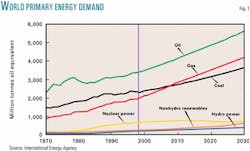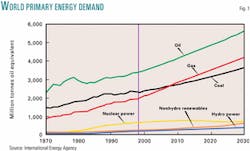IEA: World energy demand to grow briskly to 2030
Worldwide energy demand is set to grow by 1.7%/year to 2030, but there are abundant oil, gas, coal, uranium and renewable resources to meet this growth.
This forecast is contained in the 2002 edition of the World Energy Outlook, the flagship publication of the Paris-based International Energy Agency, which was presented at the 8th International Energy Forum in Japan last month by IEA Executive Director Robert Priddle.
He tempered this optimistic outlook, however, by warning of the "formidable challenges" to convert these resources into "accessible, reliable supplies."
Priddle explained that "Consuming countries will increasingly depend, especially for oil, on a small number of producers, some of them located in unstable political areas. To get the energy out of the ground and to the market will require investments of trillions of dollars.
"Far too many people in the world lack access to modern energy, and that energy poverty is not set to end. And, despite serious efforts by many nations, energy-related carbion dioxide emissions, which threaten to change the earth's climate decisively, continue to grow."
Oil, gas dominance
Fossil fuels will remain the dominant sources of energy used, accounting for over 90% of the increase in demand, according to IEA (Fig. 1).
Oil demand will increase even faster than in the past 30 years, by 1.6%/year to 120 million b/d by 2030 from 75 million b/d in 2000.
Almost three quarters of new incremental oil demand will come from the transportation sector, so that there will be a shift in all regions to light and middle distillates production, away from heavy oil products used mainly in industry.
But the fastest-growing fuel will be natural gas, which will see consumption double in volume over the 30-year outlook to 5 trillion cu m/year. The biggest markets for gas—the European Union in its present configuration and North America—will become much more dependent on imports.
Russia, the Middle East, and Africa will be the biggest exporters of both oil and gas, pulled along by transportation demand for oil and by a 2.4%/ year demand growth for gas, mainly for power generation, which will account for 60% of the gas consumption hike.
In particular, North America, which currently has sufficient gas for its needs, will become a net importer for 26% of its needs by 2030. Its oil dependence will rise to 57%. The 15 countries that now make up the EU will see their oil and gas dependency jump to 62% in 2030 from 31% in 2000. As the major oil and gas consuming nations increase their imports, energy trade is set to expand very rapidly. As for coal, consumption will be pulled by the enormous energy needs of China and India.
Developing nations' demand growth
Indeed, the greater part of the projected 60% increase in primary energy demand will come from developing countries, especially from China (which will account for 20% of the total projected increase). The IEA review devotes a full in-depth chapter to what it calls "the new energy giant."
China is set to become a major buyer of natural gas and oil by 2030. IEA predicts that China's net imports of oil will reach 10 million, equivalent to 8% of projected world oil production in 2030.
The world energy consumption share held by all countries in the Organization for Economic Cooperation and Development is expected to fall to 47% in 2030 from 69% in 2000 (Fig. 2). That compares with the developing nations' share of energy demand jumping to 43% from 34% in the same time span, and with the outlook for the former Soviet Union and its satellites, where the energy demand share will stay nearly flat at 11% in 2030 vs. 10% in 2000.
In view of the enormous investments that will be required to meet rising world energy demand, IEA points out that mobilizing such sums will depend on an investment climate likely "to persuade potential investors that they can earn a fair return on their money."
The review estimates that developing countries will need $2.1 trillion to meet growing demand for electricity generation alone. This is over double the investment in power generation in these countries over the past 30 years. Finding the funds will be a major challenge.
The review also makes the point that growth in energy use will drive up emissions of carbon dioxide. On the basis of so-far-adopted energy-efficiency or environmentally driven policies and measures, energy-related carbon emissions will increase by 16 billion tonnes by 2030, or 70% above today's level.
The lion's share of this increase will come from developing countries, with China alone adding 3.6 billion tonnes, IEA noted.


